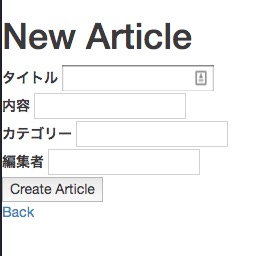Rails 登録時に他のモデルも一緒に登録する
Fri Sep 8, 2017
やりたいこと
記事の作成時に一緒にカテゴリーも作成したい。記事が親でカテゴリーが子の関係です。
rails5を使っています。記事のコントローラやモデルは作成されていて後付けでカテゴリーを追加する時の手順をメモ。

モデル作成
カテゴリーのモデルを作成。
$ rails g model category
アソシエーションの設定 atticle.rb
class Article < ApplicationRecord
# accepts_nested_attributes_forを使う、
has_many :categories, dependent: :destroy
accepts_nested_attributes_for :categories, allow_destroy: true
end
アソシエーションの設定
category.rb、rails5の場合、optional: trueの設定を忘れると動かないので注意!
class Category < ApplicationRecord
# accepts_nested_attributes_forを使う、
belongs_to :article, optional: true
end
schema.rb、categoriesテーブルにarticle_idを持たせる。
create_table "categories", force: :cascade do |t|
t.string "name"
t.datetime "created_at", null: false
t.datetime "updated_at", null: false
t.integer "article_id"
end
コントローラの設定
articles_controller.rb
newをする時にbuildしてやればいい。親が保存されると子も自動で保存される。
# GET /articles/new
def new
@article = Article.new
@article.categories.build
#2.times { @article.categories.build } 2個作る時はこうする
end
paramsの設定
def article_params
params.require(:article).permit(
:title,
:content,
:editer,
categories_attributes: [:id, :name])
end
全体は、こんな感じなる。
class ArticlesController < ApplicationController
before_action :set_article, only: [:show, :edit, :update, :destroy]
# GET /articles
# GET /articles.json
def index
@articles = Article.all
@categories = Category.all
end
# GET /articles/1
# GET /articles/1.json
def show
end
# GET /articles/new
def new
@article = Article.new
@article.categories.build
#1.times { @article.categories.build }
end
# GET /articles/1/edit
def edit
end
# POST /articles
# POST /articles.json
def create
@article = Article.new(article_params)
respond_to do |format|
if @article.save
format.html { redirect_to @article, notice: 'Article was successfully created.' }
format.json { render :show, status: :created, location: @article }
else
format.html { render :new }
format.json { render json: @article.errors, status: :unprocessable_entity }
end
end
end
# PATCH/PUT /articles/1
# PATCH/PUT /articles/1.json
def update
respond_to do |format|
if @article.update(article_params)
format.html { redirect_to @article, notice: 'Article was successfully updated.' }
format.json { render :show, status: :ok, location: @article }
else
format.html { render :edit }
format.json { render json: @article.errors, status: :unprocessable_entity }
end
end
end
# DELETE /articles/1
# DELETE /articles/1.json
def destroy
@article.destroy
respond_to do |format|
format.html { redirect_to articles_url, notice: 'Article was successfully destroyed.' }
format.json { head :no_content }
end
end
private
# Use callbacks to share common setup or constraints between actions.
def set_article
@article = Article.find(params[:id])
end
# Never trust parameters from the scary internet, only allow the white list through.
def article_params
params.require(:article).permit(
:title,
:content,
:editer,
categories_attributes: [:id, :name])
end
end
viewsの設定
フォーム画面
<div class="field">
<%= f.label :カテゴリー %>
<%= f.fields_for :categories do |category| %>
<%= category.text_field :name %>
<% end %>
</div>
フォーム画面の全体はこうなる
<%= form_for(article) do |f| %>
<% if article.errors.any? %>
<div id="error_explanation">
<h2><%= pluralize(article.errors.count, "error") %> prohibited this article from being saved:</h2>
<ul>
<% article.errors.full_messages.each do |message| %>
<li><%= message %></li>
<% end %>
</ul>
</div>
<% end %>
<div class="field">
<%= f.label :タイトル %>
<%= f.text_field :title %>
</div>
<div class="field">
<%= f.label :内容 %>
<%= f.text_field :content %>
</div>
<div class="field">
<%= f.label :カテゴリー %>
<%= f.fields_for :categories do |category| %>
<%= category.text_field :name %>
<% end %>
</div>
<div class="field">
<%= f.label :編集者 %>
<%= f.text_field :editer %>
</div>
<div class="actions">
<%= f.submit %>
</div>
<% end %>
Show画面
<p>
<strong>Category:</strong>
<% @article.categories.each do |category| %>
<td><%= category.name %></td>
<% end %>
</p>
これで終わり。
Tags
ActiveRecord
See Also